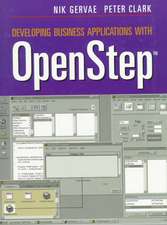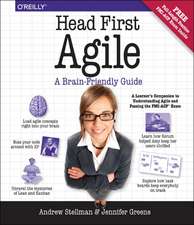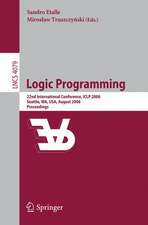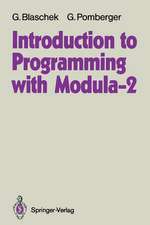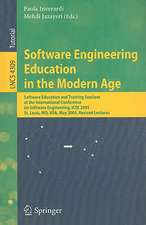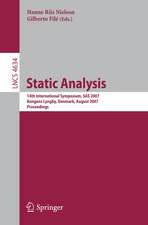Programming in Modula-3: An Introduction in Programming with Style
Autor Laszlo Böszörmenyi Cuvânt înainte de J. Weizenbaum Traducere de R. Bach Autor Carsten Weichen Limba Engleză Paperback – 15 sep 2011
Preț: 347.40 lei
Preț vechi: 434.26 lei
-20% Nou
Puncte Express: 521
Preț estimativ în valută:
66.48€ • 72.19$ • 55.85£
66.48€ • 72.19$ • 55.85£
Carte tipărită la comandă
Livrare economică 22 aprilie-06 mai
Preluare comenzi: 021 569.72.76
Specificații
ISBN-13: 9783642646140
ISBN-10: 364264614X
Pagini: 600
Ilustrații: XXII, 571 p.
Dimensiuni: 155 x 235 x 32 mm
Greutate: 0.83 kg
Ediția:Softcover reprint of the original 1st ed. 1996
Editura: Springer Berlin, Heidelberg
Colecția Springer
Locul publicării:Berlin, Heidelberg, Germany
ISBN-10: 364264614X
Pagini: 600
Ilustrații: XXII, 571 p.
Dimensiuni: 155 x 235 x 32 mm
Greutate: 0.83 kg
Ediția:Softcover reprint of the original 1st ed. 1996
Editura: Springer Berlin, Heidelberg
Colecția Springer
Locul publicării:Berlin, Heidelberg, Germany
Public țintă
ResearchCuprins
1 What is programming?.- 1.1 An informal introduction.- 1.2 The von Neumann Computer.- 1.3 Rigid thought structures.- 1.4 Programming in the small.- 1.5 Levels of programming.- 1.6 Programming and Computer science.- 2 Metalanguages.- 2.1 Definition of formal languages.- 2.2 Digits and numbers.- 2.3 Names.- 2.4 Arithmetic expressions.- 2.5 Extension for Modula-3 syntax.- 3 The structure of programs.- 3.1 Structuring.- 3.2 Language environment.- 3.3 The statics and dynamics of a program.- 3.4 Structure of Modula-3 programs.- 4 Predefined data types.- 4.1 Integers.- 4.2 Logical type.- 4.3 Characters.- 4.4 Texts.- 4.5 Floating-point numbers.- 5 Statements.- 5.1 The assignment.- 5.2 Structured Statements.- 5.3 Sequence.- 5.4 Branches.- 5.5 Loops.- 6 User-defined simple types.- 6.1 Enumeration.- 6.2 Subranges.- 7 Expressions and declarations.- 7.1 Expressions.- 7.2 Declarations.- 7.3 Equivalence of types.- 7.4 Subtypes.- 7.5 Assignment compatibility.- 7.6 Expression compatibility.- 8 Composite static types.- 8.1 Arrays.- 8.2 Records.- 8.3 Sets.- 8.4 Comparison of arrays, records and sets.- 8.5 Packed data types.- 9 Structuring algorithms.- 9.1 Block structure.- 9.2 Procedures and functions.- 9.3 Modes of parameter passing.- 9.4 Identifying the procedures.- 9.5 Name, type and default value of a parameter.- 9.6 Eval statement.- 9.7 Procedure types.- 10 Modules.- 10.1 Structure.- 10.2 Using modules.- 10.3 An example with graphic elements.- 10.4 Modularization.- 11 Dynamic data structures.- 11.1 Dynamism in static data structures.- 11.2 Dynamic data in Modula-3.- 11.3 Subtypes.- 11.4 Abstract and encapsulated data types.- 11.5 Dynamic structures.- 12 Recursion.- 12.1 Recursive algorithms.- 12.2 Recursive data structures.- 13 Objects.- 13.1 Object-oriented modeling.- 13.2 Object-oriented programming.- 13.3 Object types in Modula-3.- 13.4 Encapsulation of object types.- 14 Persistent data structures.- 14.1 Files.- 14.2 Files in Modula-3.- 14.3 Persistent variables.- 15 Exception handling.- 15.1 Exceptions in a program.- 15.2 Exception handling in Modula-3.- 15.3 Delaying exception handling.- 15.4 Strategies for exception handling.- 16 Parallel programming.- 16.1 Motivation for parallelism.- 16.2 Parallel programs.- 16.3 Threads in Modula-3.- 16.4 Shared variables.- 16.5 Message passing.- A small database.- B Language Definition.- C Library interfaces.- D Modula-3 language environments.
Textul de pe ultima copertă
The difficulty of programming lies in the need to bring our ideas into a form that can be processed by a machine. This book shows how to write and understand even complex programs by applying proper structures and good style. It uses the programming language Modula-3, which relies on and extends the well-known concepts of Pascal and Modula-2. The steps needed to become an expert programmer are based first of all on the elegant type concept of Modula-3. The programming style supported by this concept leads the reader step-by-step toward coping with complex data structures and algorithms. Such new and exciting subjects as object-oriented and parallel programming are touched upon. The book requires no prior programming experience.


